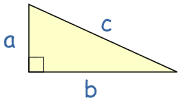User:UnaVuckovic/ThePythagoreanTheorem
The Pythagorean Theorem
In mathematics, the Pythagorean theorem or Pythagoras' theorem relates to the three sides of any right angle triangle. This theorem states:
In any right-angled triangle (triangle with one angle of 90°) the area the hypotenuse (side opposite from right angle) is equal to the sum of the areas of the other two sides.[1] This theorem can also be written as an equation using the variables a, b and c, to represent the sides of the triangle.


+ =
In this equation c represents the length of the hypotenuse while a and b represent the lengths of the other two sides
Try It!
Lets say you are given a triangle like this:

You need to find the value of x. So you plug in the Pythagorean Theorem...
+ =
a = 3
b = 4
c = x
NOTE: a and b and interchangable
+ =
9 + 16 =
25 =
=
NOTE: and cancel eachother out
x = 5
Pythagoras

This geometric theorem is named after the famous and controversial philosopher Pythagoras who was born in 569 BC in Samos, an island off the coast of Greece. Many would consider him a mathematician as he constantly studied even and odd numbers, triangular numbers, perfect numbers etc. Although the theorem was well known to the Babylonians 1000 years prior, Pythagoras was the first person to prove it, hence the theorem being named after him.[2] The whereabouts about his death are unclear but it is known that Pythagoras died in 475 BC.
References
[1] Judith D. Sally, Paul Sally (2007). "Chapter 3: Pythagorean triples". Roots to research: a vertical development of mathematical problems. American Mathematical Society Bookstore. p. 63. ISBN 0821844032. http://books.google.com/books?id=nHxBw-WlECUC&pg=PA63.
[2] J J O'Connor and E F Robertson (1999). "Pythagoras of Samos". University of St Andrews, Scotland. http://www-history.mcs.st-and.ac.uk/Biographies/Pythagoras.html







